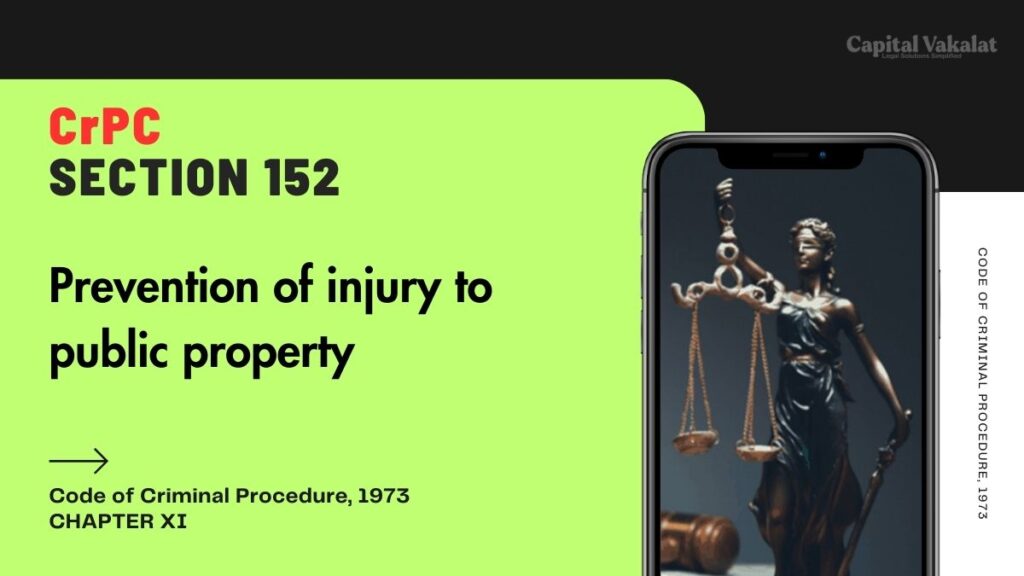Section 152 of the Code of Criminal Procedure (CrPC) in India plays a crucial role in maintaining public order and safeguarding public property. This provision empowers law enforcement agencies to take preventive measures to avert damage or injury to public property.

The essence of Section 152 CrPC lies in its proactive approach, allowing authorities to act before any harm is done, thus ensuring the safety and integrity of communal assets.
Bare Act. Section 152 Cr.P.C.
Prevention of injury to public property.
A police officer may of his own authority interpose to prevent any injury attempted to be committed in his view to any public property, movable or immovable, or the removal or injury of any public landmark or buoy or other mark used for navigation.
The Importance of Section 152 CrPC
Public property, encompassing infrastructure like roads, bridges, public buildings, parks, and utilities, is essential for the functioning of society. Damage to such property not only incurs financial costs but also disrupts public services and poses safety risks. Section 152 CrPC is a legal tool designed to prevent such occurrences by enabling police officers to act preemptively.
Legal Framework and Provisions
Section 152 CrPC is embedded within a broader legal framework aimed at maintaining public order. It grants police officers the authority to prevent the commission of offenses related to the destruction or damage of public property. This provision is invoked when there is a reasonable belief that a person or group intends to commit such an offense.
Authority and Responsibilities of Police Officers
Under Section 152 CrPC, police officers are vested with specific powers to prevent harm to public property. They can:
- Disperse unlawful assemblies: If a group is found gathering with the intent to damage public property, officers can order them to disperse.
- Use reasonable force: If necessary, police can employ force to prevent imminent damage.
- Arrest without warrant: In situations where immediate action is required, officers can arrest individuals without a warrant to prevent the commission of an offense.
Application of Section 152 CrPC
The application of Section 152 CrPC is scenario-dependent, requiring a nuanced understanding of potential threats and appropriate preventive measures. Here are some common situations where this provision is applied:
Protests and Demonstrations
Public protests and demonstrations, while a democratic right, can sometimes escalate into violence, leading to damage to public property. Section 152 CrPC empowers police to monitor such events and intervene if there is a credible threat to public assets.
Riots and Civil Unrest
During riots or periods of civil unrest, public property is often targeted. Section 152 CrPC allows police to take preemptive actions, such as imposing curfews or dispersing crowds, to protect communal assets.
Challenges in Enforcement
While Section 152 CrPC is a powerful tool, its enforcement is fraught with challenges. Balancing preventive action with civil liberties, such as the right to assemble and protest, requires careful judgment. Misuse of this provision can lead to allegations of heavy-handedness or violation of rights, thus necessitating a balanced approach.
Case Studies and Examples
To understand the practical application of Section 152 CrPC, examining case studies provides valuable insights. Instances where timely police intervention prevented significant damage to public property highlight the effectiveness of this provision.
Example 1: Preventing Vandalism During Protests
In a recent protest against government policies, intelligence reports indicated a faction planning to vandalize public buildings. Invoking Section 152 CrPC, police preemptively dispersed the assembly, thereby averting potential damage and maintaining public order.
Example 2: Protecting Public Infrastructure During Riots
During a riot sparked by communal tensions, police received credible information about plans to destroy a vital bridge. Officers used their powers under Section 152 CrPC to impose a temporary curfew and deploy forces to safeguard the infrastructure, successfully preventing any harm.
Public Awareness and Cooperation
Effective prevention of damage to public property also relies on public awareness and cooperation. Educating citizens about the importance of public property and the legal consequences of its destruction fosters a sense of communal responsibility. Moreover, community engagement initiatives can help in reporting potential threats, allowing timely police intervention.
Conclusion
Section 152 CrPC is a vital component of India’s legal framework aimed at preserving public property. Its preventive approach not only saves financial resources but also ensures the continuous availability of essential public services. However, its enforcement must be balanced with respect for civil liberties, requiring judicious application by law enforcement agencies. Through public awareness and responsible policing, the potential of Section 152 CrPC to prevent injury to public property can be fully realized, contributing to a safer and more orderly society.
Frequently Asked Questions
How do police use Section 152 CrPC?
Police use Section 152 CrPC by dispersing unlawful assemblies, using reasonable force, and arresting individuals without a warrant to prevent harm to public property.
What types of public property are protected under Section 152 CrPC?
Public property protected includes infrastructure like roads, bridges, public buildings, parks, and utilities.
Can Section 152 CrPC be used during protests?
Yes, Section 152 CrPC can be invoked during protests if there is a credible threat to public property.
What challenges exist in enforcing Section 152 CrPC?
Challenges include balancing preventive action with civil liberties, such as the right to assemble and protest, and avoiding misuse of power.
Why is public awareness important for Section 152 CrPC?
Public awareness is crucial as it fosters a sense of responsibility towards public property and helps in reporting potential threats for timely police intervention.